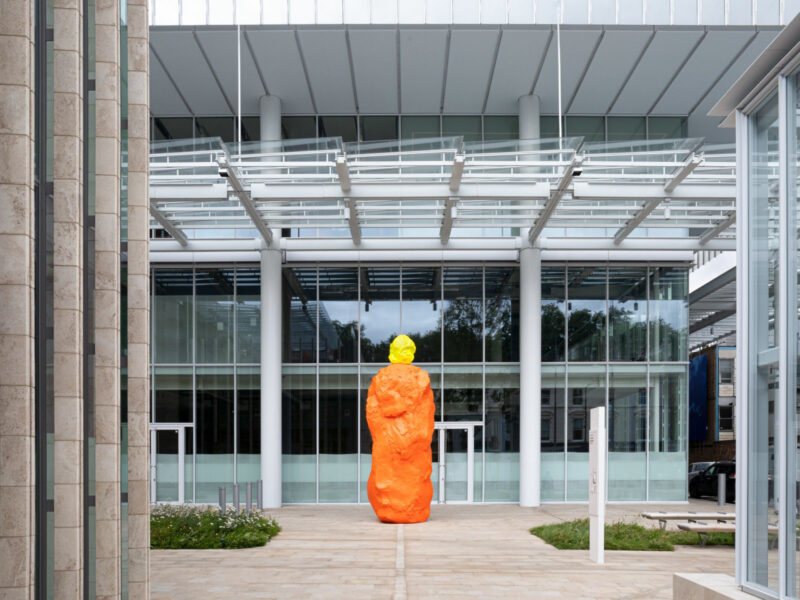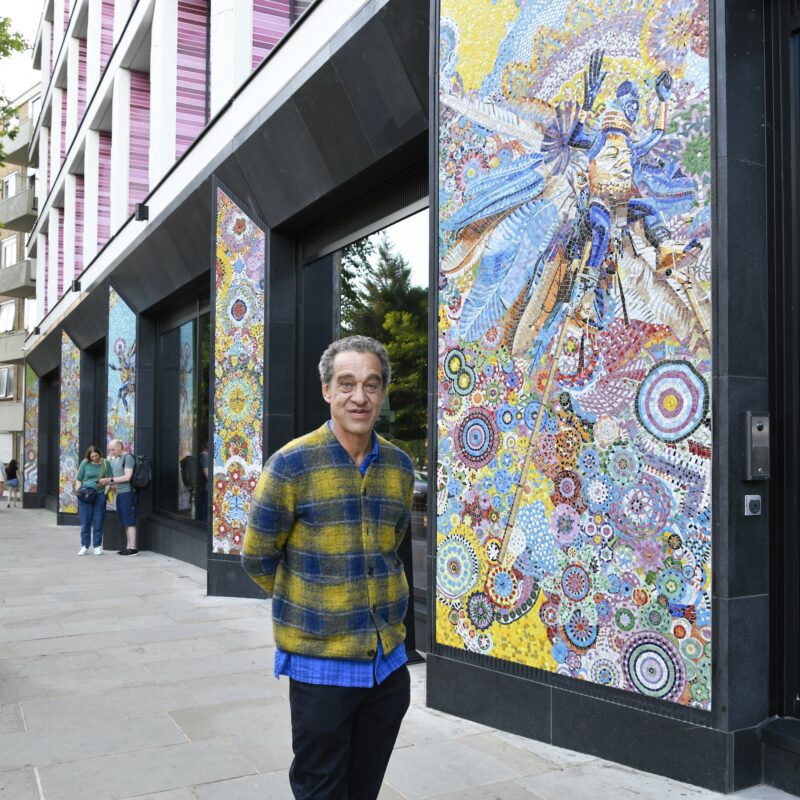An alien has descended on Bermondsey Square, but don’t worry it’s just a new Public Art sculpture by artist Karen Tang. Unveiled on Tuesday 7th October the sculpture is inspired by sci-fi film The Giant Behemoth which was set in Bermondsey in the 1950s.
Titled Synapsid, the sculpture is made of neon yellow and green fibreglass which references the atomic radiation which awakened the monster Behemoth in the film. Although the sculpture may appear alien to the area, Tang was inspired by footage in the film of Bermondsey. The sculpture is part of a comission from Arts Council and Vitrine Gallery.
1) How important was the location of Bermondsey Square to your sculpture? What were your impressions of the square when you first saw it with the commission in mind?
When making work for public space, I like responding to the site. Whilst researching the area I discovered the film ‘The Giant Behemoth’ (1959) which featured Bermondsey. That became the inspiration for the sculpture. Bermondsey Square is a recent development containing residences and businesses that embody the aspirational lifestyle of the Bermondsey’s regeneration. I was immediately tempted to create something a bit audacious to rumple the tasteful, fairly neutral design.
A tongue-in-cheek comment on public sculpture somehow ‘invading’ the space – the monster from the film literally tramples down local streets. I wanted to create a bold sculpture that would formally offset the clean geometric lines and muted colours, perhaps reflecting the energy of people enjoying the bars, restaurants, cafes in the Square. The Square is also a busy local thoroughfare and home to weekly markets, so I wanted people to be able to physically interact with the structure and space within it.
2) The Giant Behemoth film is a black and white picture produced during the onset of the Cold War, a context this piece is linked to. How does your neon pallet relate to that context, and also the aesthetic context of today?
In the film, radiation from atomic testing in the ocean was responsible for awakening/mutating a preserved dinosaur into the monster Behemoth. The colours of my sculpture Synapsid reference popular culture’s representation of radioactivity as shades of glowing green, yellow and blue. Now, such colours are also associated with the revolutionary transgenic animals that fluoresce because the genetic material from jellyfish has been inserted in their embryos.
In addition, I used the zinging hues to create a heightened awareness of the surroundings. Instinctively we respond to neon colours as signals of spectacle or alarm, for instance, in high visibility clothing and signage There is also a relationship with the aesthetics of nightclubs and raves; for me there is the context of venues in the nearby London Bridge railway arches.
3) The sculpture is moulded and irregular. It has some sort of limbs, but do you see it as an animal/alien form? Or as an abstract form?
Synapsid is carved to appear squishy and moulded. The surface is rock-hard but looks gel or plasticine-like. It was my intention from the start to exploit the ability of sculpture to fluctuate between abstract and representational.
The title reveals my starting point of evolving, morphing animal qualities that came from the pre-production plan for The Giant Behemoth to be a radioactive blob rather than a dinosaur. Synapsids were proto-mammals with origins long before the Jurassic age. Their name comes from the Greek meaning ‘fused arch’ referring to the shape of the skull; this is evident in the forms making up my Synapsid. I was also inspired by the head of Jackson’s Three-horned Chameleon as a symbol of change.
4) Do you see trends in contemporary sculpture or other contemporary artists who move away from measured precision and towards irregularity? If so, why do you think this is?
Many of my sculptures have incorporated tension between geometric and organic form; juxtaposing control and unpredictability. I think the relationship between looseness/chance and the measured/exact are fundamental investigations in sculpture and not a trend. The choice whether to use measurement systems, found objects or more indeterminable plastic/glyptic forms has conceptual roots in art historical and wider contexts. Digital sculpting technologies are also present in the discussion, and perhaps with the rise of 3D printing we are currently seeing a re-evaluation of craft or less ‘precise’ hand-made sculptural processes.
5) Which artists inspire you? Contemporary or from history.
So many it’s hard to say, but perhaps especially artists that have sculptural works with science fiction references such as Christina Iglesias and Eduardo Paolozzi. I have been told that several of my inspirations are visible in this commission – Henry Moore, Franz West, Niki de Saint Phalle and I enjoyed seeing a Sterling Ruby show just as I was starting work on Synapsid.
6) What other sci-fi films have inspired you? Which is your favourite? Do you like contemporary sci-fi films too?
The whole landscape of sci-fi cinema has affected me with the vast variety of concepts, exploration and visual imagination. Many of the classics, from Metropolis to Forbidden Planet, to the Alien and Terminator films, Bladerunner and 2001: A Space Odyssey. I love Dark Star for its berserk humour – the bouncy beach ball alien on claws and philosophising talking bomb.
From a sculptural point of view, it is inspiring that some recent sci-fi environments take our awareness of 3D space to another level. Avatar offers the fantastic CGI development of James Cameron’s deep-sea influences seen earlier in the Abyss. Avatar also uses the scenery of anti-gravity floating mountains in Zhangjiajie in China which are mind-blowing natural wonders. also liked the disorientation of spatial perception in Gravity, Enders Game and Inception.
Synapsid will be in Bermondsey Square until March 2015.








